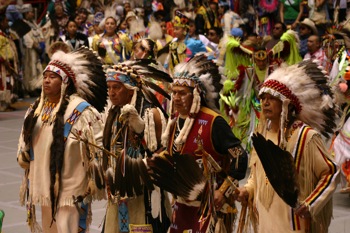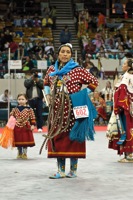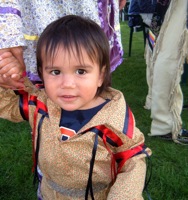
Over and over, softly and steadily, the drumbeats sound, and a small chorus of voices lightly fills the air. As the music plays, the arena begins to fill, and hundreds or thousands of Native American dancers make their grand entry in full regalia. All at once, centuries of tradition and pride come into view.
For Native American artists, dancers and musicians, powwows and other cultural events are an exciting opportunity to celebrate the customs that link them to past generations. For visitors, they are an exciting opportunity to share in the traditions of dozens of different tribes.
Hundreds of powwows and other Native American events take place across the country each year. Many feature music and dance competitions, as well as art shows, food tastings and other experiences. Some include craft markets, parades, concerts or film festivals.
Make time to take your group to one of these events, and you’ll find an enriching encounter with today’s Native Americans and the traditions they hold dear.
Denver March Powwow
Denver
Although every event has its own special twist, many powwows across the country follow the same basic structure. The Denver March Powwow in Colorado incorporates many ceremonial elements and traditional dances that will be found at similar events nationwide.
 |
| Courtesy Denver March Powwow |
“For someone who doesn’t understand, the best way to describe a powwow is like an American Indian festival,” said Grace Gillette, executive director of the event. “We have dancing, music, storytelling, arts and crafts, and we have traditional food for sale.”
The Denver event began in 1974 when a local Indian center began encouraging young people to learn traditional dances. The effort spawned a local gathering, which quickly grew to a national event. Today, the powwow features well over 1,000 dancers; last year’s lineup included participants representing 92 tribes from 32 U.S. states and four Canadian provinces.
Five times during the three-day festival, all of the dancers, along with the 30 or so drum groups that participate, parade into the arena in a procession known as the Grand Entry. Then the different groups take turns competing in a variety of traditional dances, accompanied by drummers who sing centuries-old songs as they keep time.
Many of the dances, such as the “northern traditional,” come from ancient Indian customs.
“This dance style came from the people of the Northern Plains,” Gillette said. “Before they went to hunt or to war, the men would dance and mimic what they were going to do. They would pretend they were attacking the enemy or the game.”
Other customs include the grass dance, the chicken dance, the fancy shawl and the women’s jingle dress. Visitors will also see modern dances created by younger generations.
In addition to the music and dancing, groups will find a wealth of art, jewelry and regalia at the powwow.
“We have 186 booth spaces, and lots of people come in and sell ready-made art and sculptures,” Gillette said. “And then we have vendors that sell ready-made dance outfits, like fancy shawls and jingle dresses. And many vendors sell Northern Plains beadwork or silver jewelry from the Southwest.”
The 2011 powwow will take place March 18-20.
www.denvermarchpowwow.org
Festival of Native
American Culture
Sedona, Ariz.
The Verde Valley Chapter of the Arizona Archaeological Society hosted the first annual Festival of Native American Culture in Sedona last year as a means of raising money to protect important cultural sites.
 |
| Courtesy Festival of Native American Culture |
“Because of budget cuts, many prehistoric Native American sites are being neglected and not protected,” said chapter president Ken Zoll. “So we decided we needed to do some fundraising to help the Forest Service protect these sites. Over time, we hope to develop a fund to help protect and interpret these sites.”
To help raise money, the festival features a variety of arts media. This year’s event begins with a two-day art show, June 5-6, with work from artists who have been specifically invited to exhibit at the festival. The festival committee tries to encourage a variety of crafts beyond traditional Southwestern jewelry such as Hopi carvings, Navajo pottery, and Native American rugs and paintings.
During those same evenings, a film festival highlights cinematic works by Native Americans.
“They have to be produced or directed by Native Americans,” Zoll said. “We’ve learned that sometimes it’s inappropriate for nonnatives to do films about Native American culture. So we’re trying to encourage Native American filmmakers to tell their own stories.”
Throughout the festival, visitors will find musical performances going on in two different high-traffic areas of Sedona. The celebration closes with a concert that will feature Indian performers playing traditional and contemporary music.
www.festivalofnativeamericanculture.org
Genundowa Festival
Hammondsport, N.Y.
During the golden age of the Iroquois in New York, the Seneca elders in the village of Genundowa would build a massive fire on top of Bare Hill every fall to give thanks for peace and an abundant harvest. Encampments along the shore would light small fires in response, and the tradition became known as Genundowa, the Seneca festival of lights.
 |
| Courtesy Genundowa |
Seneca people living in modern Hammondsport continued the tradition throughout the 20th century, although it eventually lapsed into a weekend holiday at the lake. Sixteen years ago, locals Ellen Shaw-Maceko and Bob Magee decided to bring the celebration back to its roots with a Labor Day weekend festival.
“The event takes place in a park with food vendors, craft people storytellers and music,” Shaw-Maceko said. “Saturday night is the celebration fire. Several thousand people are there — the lakefront is absolutely packed, and there are a lot of boats out on the water watching it as well.”
Festivities include performances by a number of Iroquois musicians from the area, as well as flute performances by a Grammy-nominated Cheyenne flautist. Singers and dancers from the Onondaga nation perform traditional celebration dances for the crowd and then teach the steps and invite spectators to join in and dance along.
Visitors can also sample Seneca and Iroquoian food specialties.
“Corn soup is very popular,” Shaw-Maceko said. “There are various ways of doing venison stews and burgers, and we’ve had vendors do roasted corn that was cooked underground. Some people do strawberry drinks, because strawberry is an important fruit for the Iroquois people.”
www.genundowa.com
Gathering of Nations
Albuquerque, N.M.
What started as a small, one-time gathering of friends in Albuquerque has turned into the Gathering of Nations, the largest annual powwow in the country.
“It started 27 years ago, and it was supposed to be a small, one-time event to bring some friends together to sing and dance,” said Derek Matthews, founder and director of the powwow. But they all wanted to do it again the next year, and word of mouth spread throughout Indian country. Today, it’s a very large native festival with more than 500 U.S. tribes and more than 200 bands from Canada and Mexico.”
The song-and-dance competition features about 3,000 singers and dancers from across the continent. Traditional clothing and regalia help the dancers to reflect the customs of their ancestors, and at this powwow, visitors have the opportunity to meet the competitors and learn about their heritage.
“When spectators are sitting in the stands or walking around, they’re up close and personal with the dancers,” Matthews said. “They can meet them, talk to them and ask questions about their dance styles and their outfits. All of the outfits are handmade, and many of them have been handed down from generation to generation.”
The festival also features Trader’s Market, an area for arts and crafts vendors and other Indian demonstrations. Visitors will find paintings, pottery, jewelry, stone carving and glasswork, as well as historic herbal remedies.
A birds-of-prey exhibit and daily demonstrations are also popular.
Matthews said that another favorite aspect for visitors is Powwow Alley, where attendees can sate their appetites with traditional flavors.
“You’ll find more than 15 different native or New Mexico food vendors,” he said. “New Mexico food is really unique — our chili is like none other. You’ll also have the Navajo tacos, the buffalo stew and fry bread.”
At the festival’s Stage 49, Native American musicians play blues, reggae, hip-hop, rock and other styles of popular music. The festival takes place every year during the third weekend of April.
Red Earth Festival
Oklahoma City
The spotlight shines on Native American art during the Red Earth Festival, which takes place June 18-20 in Oklahoma City.
“This is our 24th annual event,” said Eric Oesch, deputy director of Red Earth. “It was started as a way to showcase the many talented artists that are of Native American descent. It has become the world’s largest Native American cultural event, and we have tribes from all parts of the nation.”
Unlike some other events that offer exhibit booth spaces to all comers, the art show at Red Earth is a juried event, which means that potential exhibitors must meet the standards and approval of Native American art experts. As a result, visitors will find some of the highest quality Native American art in the country.
“We have between 150 and 200 artists,” Oesch said. “They’re displaying jewelry, pottery, beadwork, turned wood and those kinds of things. It’s all handmade Native American art.”
In addition to the art show, Red Earth features a powwow-style dance contest with competitors representing more than 100 tribes from all across the United States and Canada. The dancers compete for prize money in a variety of age groups and style categories; before that begins, though, the entire contingent of dancers, drummers and Native American dignitaries parade through the streets of downtown Oklahoma City.
“The parade features all of the dance participants in their full tribal regalia,” Oesch said. “It features all of the tribal princesses, such as Miss Seminole, and we have floats and bands and people on horseback.
“We have about a dozen drum groups featured in the competition who beat the drums and sing to it. In the parade, they participate too, so you have this drum music that reverberates through downtown. You have the best of both worlds mixed together.”
A variety of other activities take place at the event as well. Groups can hear traditional and contemporary tales at the storytelling stage or sample Native American foods at the on-site bistro. The festival also includes a Saturday morning 5K road race downtown along the banks of the Oklahoma River.










